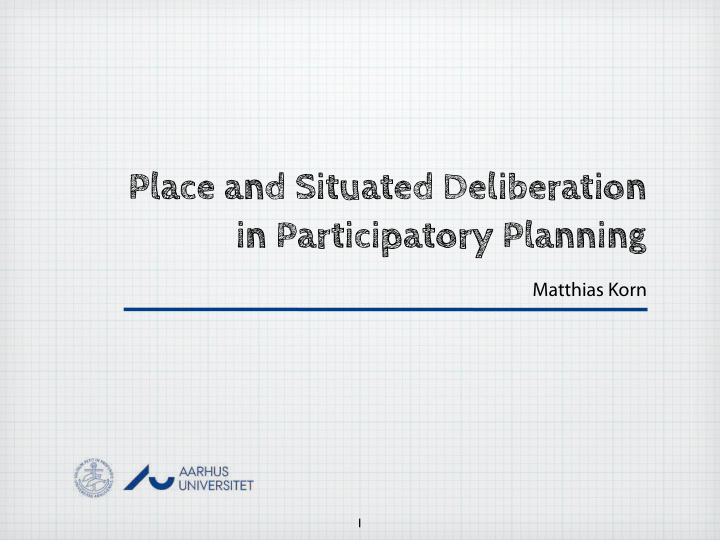



Place and Situated Deliberation in Participatory Planning Matthias Korn 1
Context and Motivation • prevalence and popularity of mobile location-aware technologies and services • use of geographic location to interact with the environment • possible actions and information are linked with these locations • however, people ascribe different meanings to these locations • understanding locations people interact with as “places” • application domain: participatory (urban) planning How can we leverage the meaning that people associate with locations in the design of systems that take location to be central? 2
Space / Place (Harrison & Dourish, 1996; Dourish, 2006) spaces... places ... ... are the structure of the world ... are spaces invested with meaning and understandings ... are geographically located ... frame appropriate behavior ... provide opportunities for practice ... are spaces that people put to use ... exist through practices of design ... are valued and meaningful ... exist through practices of use 3
Space and Place in Located Deliberation • continuous cycle of space and place in urban planning • space is what we aim to influence and what eventually gets build • place is what we experience and hope will develop • deliberation is the social construction of space – quite literally • places are flexible in the hands of different people, and contested and malleable over time • transition from closed to public places 4
Research Question How can we facilitate participatory planning of spaces by supporting the use of place(ness) as a resource for citizens in located deliberation processes? 5
Cases and Findings: Mobile Democracy • explores the combined use of GIS and mobile technologies for participatory urban planning • concept consists of two interconnected prototypes: • a smart phone prototype for in-situ reflection and action, i.e., while citizens are physically close to the planning object • a browser-based prototype for ex-situ reflection and action on proposed plans, i.e., when citizens are remote to the planning object 6
Cases and Findings: Mobile Democracy • explores the combined use of GIS and mobile technologies for participatory urban planning • concept consists of two interconnected prototypes: • a smart phone prototype for in-situ reflection and action, i.e., while citizens are physically close to the planning object • a browser-based prototype for ex-situ reflection and action on proposed plans, i.e., when citizens are remote to the planning object 7
Cases and Findings: Mobile Democracy • explores the combined use of GIS and mobile technologies for participatory urban planning • concept consists of two interconnected prototypes: • a smart phone prototype for in-situ reflection and action, i.e., while citizens are physically close to the planning object • a browser-based prototype for ex-situ reflection and action on proposed plans, i.e., when citizens are remote to the planning object 7
Cases and Findings: Mobile Democracy • explores the combined use of GIS and mobile technologies for participatory urban planning • concept consists of two interconnected prototypes: • a smart phone prototype for in-situ reflection and action, i.e., while citizens are physically close to the planning object • a browser-based prototype for ex-situ reflection and action on proposed plans, i.e., when citizens are remote to the planning object 7
Cases and Findings: Mobile Democracy • explores the combined use of GIS and mobile technologies for participatory urban planning • concept consists of two interconnected prototypes: • a smart phone prototype for in-situ reflection and action, i.e., while citizens are physically close to the planning object • a browser-based prototype for ex-situ reflection and action on proposed plans, i.e., when citizens are remote to the planning object 7
Cases and Findings: Mobile Democracy • explores the combined use of GIS and mobile technologies for participatory urban planning • concept consists of two interconnected prototypes: • a smart phone prototype for in-situ reflection and action, i.e., while citizens are physically close to the planning object • a browser-based prototype for ex-situ reflection and action on proposed plans, i.e., when citizens are remote to the planning object 7
In-situ and Ex-situ Reflection and Action Bohøj, M., Borchorst, N.G., Bødker, S., Korn, M., & Zander, P.-O. (2011, to appear). Public Deliberation in Municipal Planning: Supporting Action and Reflection with Mobile Technology. In Proceedings of Communities and Technologies (C&T 2011) . Brisbane, Australia. • distinct qualities of in-situ reflection and action as opposed to, and in concert with, ex-situ reflection and action • situating actors in the environment they are discussing about • inspired by Schön’s (1983) reflection-in-action and reflection-on- action • we found a difference between “being there” and sharing that information with others 8
Conclusion • situated deliberation may improve discussions about place by demonstrating personal relevance and creating awareness • placeness as a resource as one way of meaningfully connecting citizens to these locales 9
Citizen and Government Engagement Workshop at C&T 2011 (Brisbane, Australia) • June 30, 2011 Place and Situated Deliberation in Participatory Planning Matthias Korn mkorn@cs.au.dk http://cs.au.dk/~mkorn 10
Recommend
More recommend